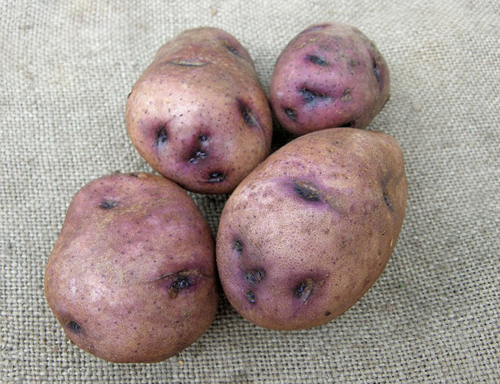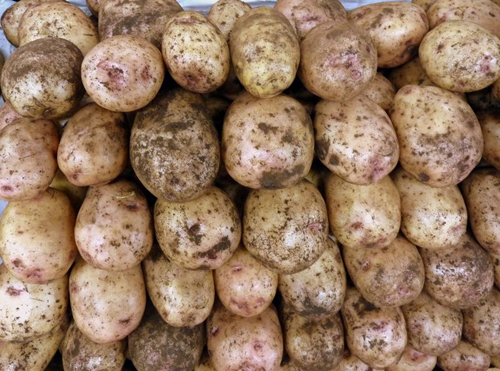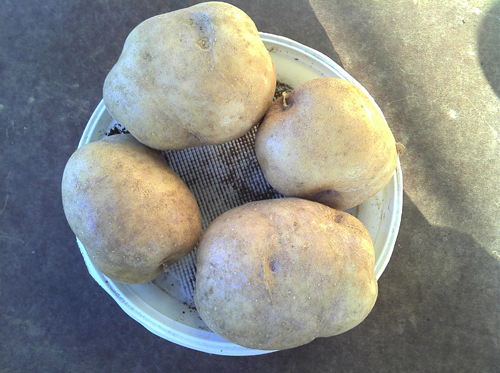Sineglazka potato variety
Sineglazka is a mid-season amateur potato variety (Solanum tuberosum), bred by the works of Russian breeders back in the 50s. It is not included in the state register of plants of the Russian Federation and has not passed state tests. However, it has been very popular among gardeners for a long time, so there is a lot of information about it. Sineglazka, or, as it is sometimes called, Hannibal, is intended for cultivation only on individual plots for personal consumption, it is unsuitable for industrial cultivation. Zoned in the Central region of the country, as well as in more southern latitudes. The most common in the Smolensk, Kaluga and Moscow regions.

Let's talk a little about the interesting history of this variety. It dates back to the post-war period, when SI Domin, an employee of the Institute of Starch Products, worked on its creation. To breed it, cultivated potatoes were crossed with wild ones, as a result, a successful result was obtained. The new variety received selection number 15 555 and was sent for testing to experimental stations and strongholds of VNIISP. The tests took place in various natural and climatic zones of the USSR, but the novelty "got accustomed" best of all at the Smolensk Experimental Station. Its employees decided to distribute the variety throughout the region, for which the seed material was transferred to many farms and amateur potato growers. In small areas, the plant has proven itself well, but in production areas, the success was much lower, if not completely absent, due to the poor keeping quality of tubers. But gardeners, including B.P. Nazarenko, an employee of the Smolensk Experimental Station, liked the variety very much for its high yield, good taste and resistance to diseases. By the way, Sineglazka got its name precisely thanks to Nazarenko, who tested it on his personal plot, so to speak, in “field conditions”.
The time from full germination to harvest is 70 to 90 days.
The plant is large, spreading, with very strong stems and an abundant amount of green mass. Leaves are medium in size, dark green. The flowers are small, light blue in color, and their number is usually small. Very few berries are produced.

The root system is well developed, tuberization begins early. The tubers are large, round or oval, slightly flattened, with an average weight of 70 - 150 grams. The skin is thin, but dense, point-colored in a faint blue color, which is why it has a pinkish-gray tint. The pulp is white, firm. The eyes are few, they are small, shallow, have a bright blue, even purple color, due to which they stand out against the general background. By the way, hence the name - Sineglazka.
The output of tubers from one plant is 8-12 pieces. The yield is high, up to 500 kg / ha, or up to 500 kg per one hundred square meters. The figure may vary depending on the planting material, soil composition, and especially weather conditions.
The taste qualities of tubers are very high. In cooking, they have a universal purpose, suitable for preparing a variety of dishes. The digestibility of tubers is average, the starch content in them is about 15%. By the way, there is a widespread opinion among the people that it is from this potato that the most delicious mashed potatoes are obtained!
The main disadvantage of the variety is the inability to store it. Even during field trials, this problem became a decisive factor in his future fate - he was recognized as hopeless, as a result of which the area of its distribution was limited only to amateur garden plots. When laying large batches, about 75% of the tubers rot. So, back in 1952, out of six heaps put in storage, only two remained conditional.

In agricultural technology, this potato is absolutely simple and does not require special care. Prefers light and fertile soils with neutral acidity. Light loam and sandy loam are best suited.Below are some simple tips for growing and caring for plants.
- Planting is carried out in early to mid-May, when the soil warms up to + 8 ° C.
- The landing site should not be in the shade.
- The planting depth of tubers is about 10 cm in loose soils, in more dense soils - 7-8 cm.
- The row spacing should be 60 - 70 cm, the distance between plants should be 40 cm.
- As necessary, watering and fertilizing plantings, as well as weeding and processing from pests and diseases, should be carried out.
- Remember to maintain a crop rotation. The best predecessors are legumes, green manures, cabbage, cucumber, beets, onions and garlic.
It is also worth mentioning one nuance associated with the cultivation of these potatoes. Since it was bred quite a long time ago, it tends to degenerate if you only use your own planting material. Therefore, it should be completely replaced every 4-5 years. However, difficulties may arise with this, since Sineglazka is not cultivated on an industrial scale. In addition, some unscrupulous potato growers, taking this opportunity, sell completely different varieties under its guise, which are nothing outstanding.
Another feature associated with the age of the variety is the strong dependence of yield on weather conditions. When the air temperature rises to + 30 ° C, the growth of tubers slows down significantly. To protect plants from the harmful effects of heat, you need to provide shading of the area and moderate watering, you can also apply mulching. With a cold snap, the situation is more complicated, but to combat this problem, gardeners have a whole arsenal of techniques that you are most likely already familiar with. As for the abundant rainfall, they are usually not terrible for potatoes, however, when harvesting, the tubers should be better dried.
Sineglazka has an average resistance to various diseases, least of all it is affected by cancer, late blight and scab. According to some reports, the wireworm loves her, while the Colorado potato beetle bypasses.
In the end, I would like to say that this variety, despite its unsuitability for long-term storage, is still in demand among gardeners because of its excellent taste, high yield and undemanding care.









My favorite! I increased the amount of planting material in relation to other varieties to 65%. I grow not because of the yield (white varieties like Nevskaya or Udachi will be more stable "from year to year" and will be more productive), but because of the excellent taste, which cannot be compared with any other variety! If the other varieties are used by me as a side dish, then Sineglazka itself can be the main dish without meat and other things, just season it with butter! In principle, I would not grow potatoes, but from year to year what is sold in stores is getting worse and worse in taste, sometimes it just starts to feel sick from the stench of simple boiled purchased potatoes - it is simply inedible. For example, I never thought that potatoes could spoil the taste of a soup - it turns out that you can! The variety is really prone to degeneration - out of youthful stupidity, he got rid of it at one time due to a decrease in yield - in fact, peas grew. Now I'm trying to get young growth from the only one on the plantation of 1.5 hundred square meters :) He is very responsive to the quality of the soil (he likes loose), fertilizers (it would be nice to combine organic matter with mineral water) and to moisture - he does not tolerate dryness, does not tolerate moisture either. The pulp is white. Highly starchy. Prone to boiling.The tubers do not creep in the hole. By the way, in amateur gardening it is stored no worse than any other varieties of potatoes. But thanks for all the work with taste! I definitely recommend at least giving it a try!